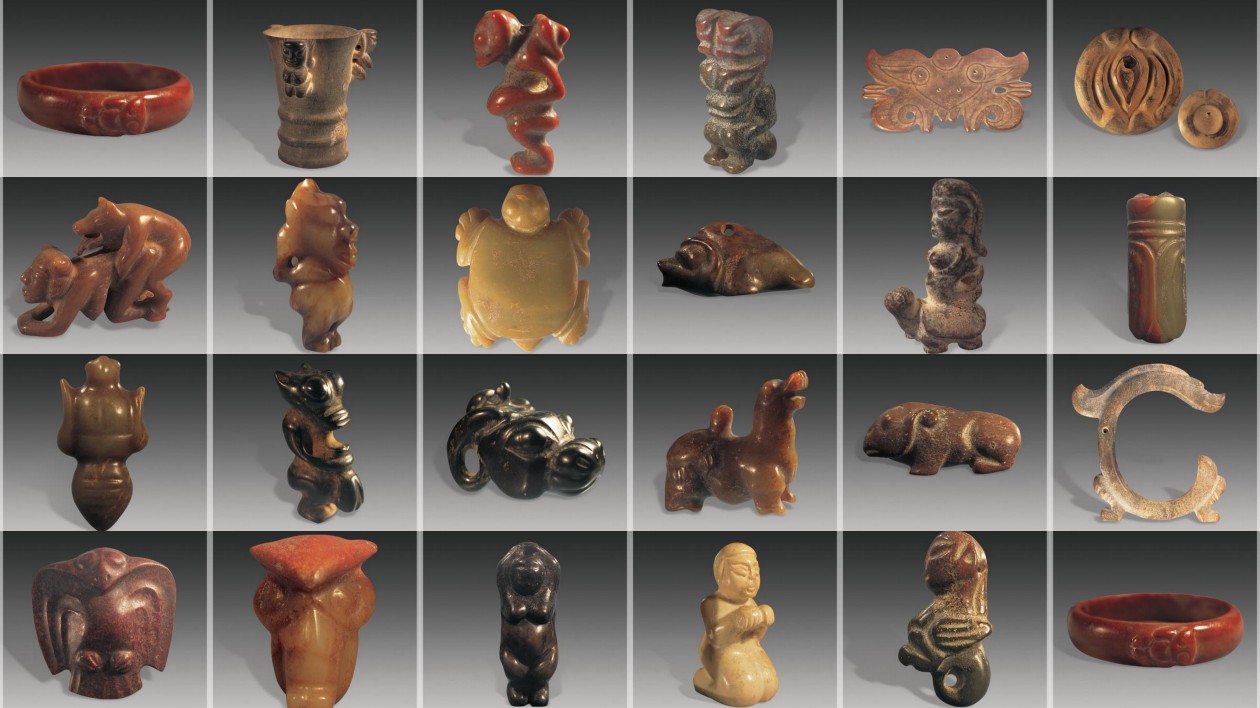宗教人物:
下面我们介绍三件与原始宗教礼仪相关的人物造型:
Religious figures:
Here we introduce three figures associated with original religious rituals:
Fig 1.3
1.3 长耳垂人
高19.5cm,宽12cm,厚9cm ,重2.1kg。
青玉,玉质温润,全沁呈棕红色。
其造型为一高大魁伟之双手合十长耳垂人,呈蹲式,双手
合十于胸前。头部造型与南宋杭州飞来峰石刻布袋弥勒相
似,环目,蒜头鼻,嘴角上弯,满面笑容,大耳垂肩,一
副欢快慈祥的面孔。整体造型生动,比例适度,对称性
好,加工洗练。泛红山文化玉器中出现类似布袋弥勒之造
型,向人们揭示了原始宗教神秘的传承性。此件玉器为研
究泛红山文化的原始宗教提供了重要的实物资料。
《山海经》中有关于“聂耳国”的记载,聂耳国人有拉长耳朵的习俗,
这一习俗曾扩散到太平洋周边的一些地区,如法属破里尼西亚群岛,
复活节岛等地。这些地区的原住民至今还保持这个习俗。顺便告诉你
一个小秘密:经常拉捏耳朵真的有利于健康。
1.3 Man with long ear lobes
High: 19.5cm, width: 12cm, thickness: 9cm, weight: 2.1kg.
The jade is in good quality, green in color with reddish brown markings.
The modeling is a tall burly man, squatting likes. He has a pair of long ear lobes, his palms facing together in front, his head shape just like the Maitreya Buddha in Buddhism, lips curved, smiling like, and large lobes drooped on shoulder, a happy face with compassion. The overall shape is vivid, moderate proportion, symmetry good and refined.
The similar image of the Maitreya Buddha occurred in the Pan-Hongshan cultural jade group revealed the mystery of the original religions inheritance. This jade statue is an important practical material for studying the primitive religion.
“Shan Hai Jing” classics has recorded the old country named Nie Er, stretching ears was a particular custom in that country, this custom had spread many parts of the Pacific rim, such as the French Polynesia, Easter Island and other regions, the indigenous people of these regions have been remaining the custom. By the way, tell you a little secret: elongating ears is rally conducive to health.
—
Fig 1.4
1.4 盘坐姿女子
高7cm,宽2.5cm,厚1.5cm。
青玉,玉质莹润,有红色沁色。
其造型为一女子,盘坐,双手合十贴于胸前,大头、大
眼,眼梢上挑,扁鼻,闭口,短发披散于耳边,颈后有一
对钻牛鼻穿。整体造型为一盘坐修练的女子,亦或是一尊
女神像。此造像证明盘坐修练姿势并非始于佛教,原始宗
教已有。《山海经》中有“交胫国》的记载,交胫即是
两小腿交叉的盘坐姿,是原始宗教中祭拜的姿势。
1.4 Woman in cross-leg sitting posture
High: 7cm, width: 2.5cm, thickness: 1.5cm.
The jade is in good quality, green in color with red markings, waxy luster.
The modeling is a cross-leg sitting woman, her palms facing together to put front of her chest. She has big head, big eyes, and flat nose. Her eyes slope upward, short hair spread by the ears. There is an ox-nostril-shaped hole back of her neck. The overall shape is a practice woman or a goddess statue. From this statue we know that this practice style not started from Buddhist, it began with primitive religion. There is a “cross-shin state” recorded in <Shan Hai Jing> classics, “cross-shin” means sitting and two shanks in cross-shaped posture, it is the practical posture in primitive religion.
—
Fig 1.5
1.5 巫师
高6cm,宽2cm,厚2cm。
熊胆青玉,有灰皮及棕红沁色。
造型为一立姿巫师,两眼望天,双手合于脑前,掌心向
外。身着长衫,腰下系一玉鹰,朝向正面。颈后有一对钻牛
鼻穿。
巫师腰下饰鹰,表示鹰是他的氏族图腾。值得注意的是在
良渚文化玉器中也有与此相似的巫师造像,这显示了原始宗教的传承。
1.5 Wizard
High: 6cm, width: 2cm, thickness: 2cm.
The jade is in dark green color, gray skin covered, and reddish brown markings.
It is a standing shaman modeling. His eyes slope upward; hands closed together and put on his chest, palms facing outward. He wore a long gown; a jade eagle was hung on his waist, back of his neck with an ox-nostril hole. The eagle he wore is his clan’s totem. It is noteworthy that there was the similar shaman statue to this one in Liangzhu cultural jade works; it shows the inheritance of the primitive religion.
关于原始宗教的传承:
从以上三件原始宗教的人物造型,我们知道现代的很多宗教礼仪源自末次冰期时期的原始宗教。由于原始氏族社会人们的一切社会活动都是与原始宗教密切相关的,原始宗教是原始氏族社会的领导核心,也是文化中心,集中地体现了当时的文化水平和文明层次,所以原始宗教对后世的传承不仅是宗教礼仪的传承,更重要的是文化的传承。末次冰期的晚期我们人类在世界上很多地区创建过文明,这些文明不幸被末次冰期结束时的巨大自然灾难所毁灭,但很多文明因素传承到新石器时期,这种传承的重要媒介即是原始宗教。
Above primitive religious heritages:
From the above three figures we know that many modern religious rituals from the Last Glacial primitive religion. Since all of the people’s social activities were closely related to the primitive religion in the original community. The original religion was the core of the leadership and the cultural center in the primitive clan society, it epitomized the then levels of the culture and civilization, so original religious heritages for future generations were not only a religious ritual tradition, more important were the cultural heritages. During the Late Last Ice Age our humans had created civilization in many places in the world, these civilized regions unfortunately were destroyed by the huge disasters in the end of the Last Ice Age, but many civilized factors had been passed to the Neolithic period, the important medium of the heritage was the original religion.





